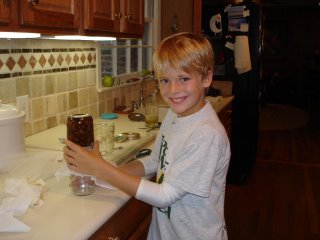
I don't know if I have Varroa mites, but if I don't it will be a miracle since they're everywhere. The master beekeepers on the
Beemaster's Forum 
have been advising that the beekeeper use a "sugar shake" in which you shake a one pound box of powdered sugar between the frames in the top brood box (so the sugar can fall through both levels of the box).
Here is a quote from Brian Bray - a well-established beekeeper on the Forum:
"
Use powered sugar. Use a shaker of some type to dust the bees down between the frames. The powered sugar will knock off enough of the mites so you'll be have an idea of their concentration. You should shake every 10 days for a month to decrease their population before the winter. A SBB helps as the mites and the excess sugar fall through the hive. The sugar shake works because the mites are dislodged from the Bees as they groom themselves and each other to get rid of the sugar. The sugar is usually converted to stores."

Well, first I had to buy powdered sugar. There was some discussion about whether the powdered sugar had starch in it or not and both Brian Bray and Michael Bush, both wise beekeepers, in separate postings said, "IMO powdered sugar is the best." I have to confess that I spent some time on Google searching to find out what brand IMO Powdered Sugar is before I realized that they were both saying, "
In
My
Opinion...." DUH.

So I found powdered sugar at Costco and then went to Target for a shaker. I bought a cocktail shaker because it would hold a pound of powdered sugar and I wouldn't have to refill it with bee gloves on. I started out with the shaker, but........several vigorous shakes and the top flew off and landed on the hives, disturbing the bees more than the sugar had. So I simply sprinkled it by hand.
I brushed it off the tops of the frames into the spaces between and sugar covered the bees. They looked like little ghost bees. Hopefully they will clean each other off, removing Varroa mites in the process.


 mite count. I'll report what I find here on the blog.
mite count. I'll report what I find here on the blog.



















 small hive beetle trap
small hive beetle trap














